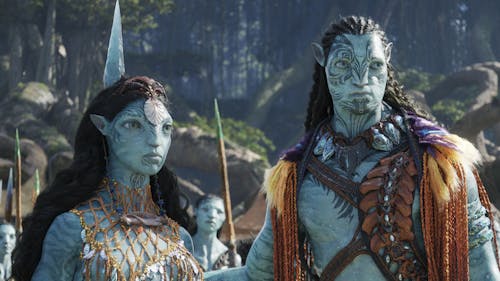'Avatar' sequel doesn't disappoint, but it doesn't surprise us either

After more than 10 years of production, the sequel to the highest-grossing movie of all time, "Avatar," was released on December 16. "Avatar: The Way of Water" is a continuation of the world of Pandora, exploring new biomes, dialects and characters.
As someone who was not the biggest fan of the franchise (and forgot most of it due to the large gap between the first and second installments), I didn't go into the movie with many expectations. I expected a visually stunning movie, which would be typical of director James Cameron, and I expected good music from composer Simon Franglen (winner of a Grammy due to his work on "My Heart Will Go On"). But frankly, the most I knew about the movie was that The Weeknd was releasing a song for it.
"Avatar: The Way of Water" sits at a lengthy run time of 3 hours and 12 minutes, which is usually only seen (in my experience) in Indian films. I had wondered how Cameron was going to fill 3 hours of film, but contrary to my expectations, he managed to make all the scenes fit perfectly.
The movie opens with a shot of the forest biome in Pandora and a long prologue that explains what exactly happened in the 10 years since the first movie was made.
The main character, Jake Sully (or his Na’vi name, Tsyeyk Suli) has five children: Neteyam, Lo’ak, Tuk, Kiri and Spider. The latter two are adopted, with Kiri being the daughter of Grace Augustine’s avatar body and Spider being the human son of the late Miles Quaritch. Jake claims he's found happiness, but he's constantly fighting to keep it every day.
We then go to the perspective of the Resources Development Administration (RDA), which plans to colonize Pandora as it claims Earth is dying and humanity is desperately looking for an escape plan. Quaritch's memories are implanted into a recombinant, and he becomes the new leader of the RDA’s efforts to suppress Jake's constant efforts to drive away the RDA. During a mission, Quaritch and his gang capture Jake’s children. Jake and his wife, Neytiri, manage to free the children but fail to rescue Spider.
The story eventually moves from the forest to the sea, where Jake and his family take refuge among the Metkayina Clan in order to escape Quaritch and the RDA, who aim to capture and kill him. The large majority of the story takes place here, with several new exciting aspects of Pandora explored.
I found that the most interesting part of this movie was the introduction of the water tribes. Cameron once again delivers on his style of striking visuals and intricate worldbuilding. In the movie, the seaboard is thoroughly traveled through various plot points that explore themes of loneliness, abandonment, courage and restraint.
The village where the Metkayina people reside acts as a wonderful backdrop to these issues — while illustrating the daily lives and interactions of the sea people and how they differ from the forest people. There, Jake and his family meet the leader of the water tribe they inhabit — Tonowari and his wife, Ronal, who allow them to stay but seem at times wary.
The action scenes are plentiful but not overwhelming. I found myself on the edge of my seat during several parts of the movie, as if I was in the battle myself. The dynamic camerawork, excellent use of setting and varied musical themes made it so that the viewer was totally immersed at all times.
The film is a wonderfully detailed return to the world of Pandora, and I simply cannot give enough praise for how varied and beautiful the ocean biosphere was. The mere fact that a language was created solely for this movie displays Cameron’s perfectionist tendencies and dedication to making great cinema.
Cameron is a legend in the film world, both praised for his work on the first “Avatar” and on countless other projects. But that doesn’t mean he’s above criticism.
"Avatar: The Way of Water" appears to have a clear message about the environment delivered through the lens of Cameron. The pervasive narrative that the RDA is bad and the Na'vi are the only victims in the film is incredibly obvious. The military soldiers exhibit the classic "bro culture" that appears to be present in many male-dominated workforces, but some of the dialogue is a tad dated and made me internally cringe for a bit.
Quaritch is such an archetypal villain that at times, it's laughable. He takes his own skull and crushes it at the beginning of the movie, clearly signifying a new beginning with his new body. His change in appearance only amplifies his arrogance and makes him quite annoying to watch at times. But due to the heavy exposition in the first movie, I believe this choice to make him almost stereotypically villainous is to alleviate some of the seriousness the movie carries.
While the prologue was somewhat dense to get through, I appreciated the background the movie offered its viewers. The addition of Jake's headstrong children was a breath of fresh air from the more heavy themes the adult characters were meant to carry. I found myself genuinely laughing at some of the lines Tuk and Lo’ak said and relating to a few themes the children were meant to represent in the movie.
The story of "Avatar: The Way of Water" is simple, but it's enough to flesh out a new chapter in Pandora's story without feeling overwhelming. It's a good sequel to a phenomenally successful movie. With talks of three more sequels in the works, I know I and many other movie-goers will be eagerly waiting to see what Cameron decides to do next with Pandora and its inhabitants.



